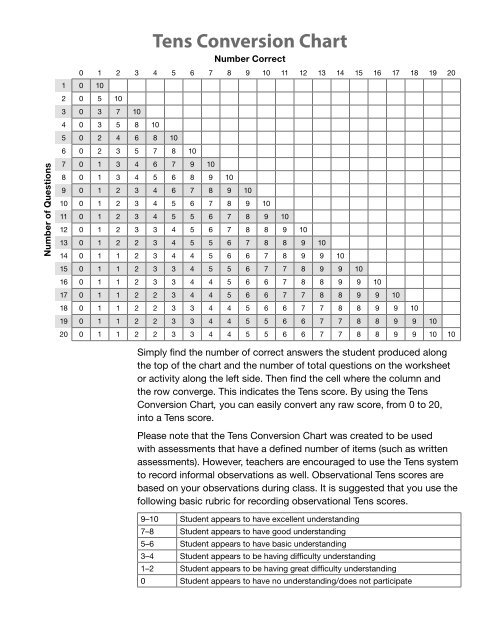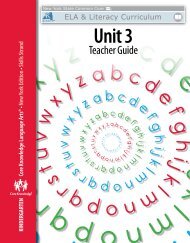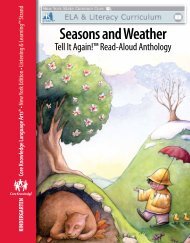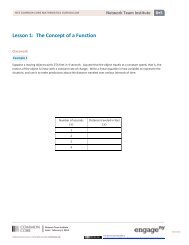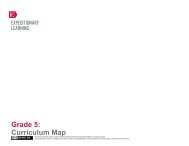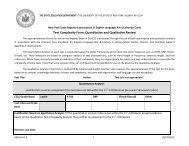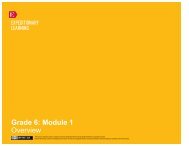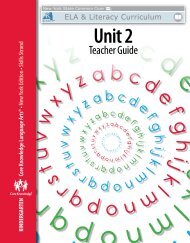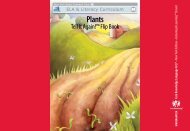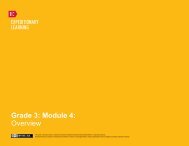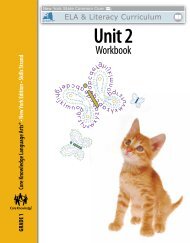Plants - EngageNY
Plants - EngageNY
Plants - EngageNY
You also want an ePaper? Increase the reach of your titles
YUMPU automatically turns print PDFs into web optimized ePapers that Google loves.
Tens Conversion Chart<br />
Number Correct<br />
Number of Questions<br />
0 1 2 3 4 5 6 7 8 9 10 11 12 13 14 15 16 17 18 19 20<br />
1 0 10<br />
2 0 5 10<br />
3 0 3 7 10<br />
4 0 3 5 8 10<br />
5 0 2 4 6 8 10<br />
6 0 2 3 5 7 8 10<br />
7 0 1 3 4 6 7 9 10<br />
8 0 1 3 4 5 6 8 9 10<br />
9 0 1 2 3 4 6 7 8 9 10<br />
10 0 1 2 3 4 5 6 7 8 9 10<br />
11 0 1 2 3 4 5 5 6 7 8 9 10<br />
12 0 1 2 3 3 4 5 6 7 8 8 9 10<br />
13 0 1 2 2 3 4 5 5 6 7 8 8 9 10<br />
14 0 1 1 2 3 4 4 5 6 6 7 8 9 9 10<br />
15 0 1 1 2 3 3 4 5 5 6 7 7 8 9 9 10<br />
16 0 1 1 2 3 3 4 4 5 6 6 7 8 8 9 9 10<br />
17 0 1 1 2 2 3 4 4 5 6 6 7 7 8 8 9 9 10<br />
18 0 1 1 2 2 3 3 4 4 5 6 6 7 7 8 8 9 9 10<br />
19 0 1 1 2 2 3 3 4 4 5 5 6 6 7 7 8 8 9 9 10<br />
20 0 1 1 2 2 3 3 4 4 5 5 6 6 7 7 8 8 9 9 10 10<br />
Simply find the number of correct answers the student produced along<br />
the top of the chart and the number of total questions on the worksheet<br />
or activity along the left side. Then find the cell where the column and<br />
the row converge. This indicates the Tens score. By using the Tens<br />
Conversion Chart, you can easily convert any raw score, from 0 to 20,<br />
into a Tens score.<br />
Please note that the Tens Conversion Chart was created to be used<br />
with assessments that have a defined number of items (such as written<br />
assessments). However, teachers are encouraged to use the Tens system<br />
to record informal observations as well. Observational Tens scores are<br />
based on your observations during class. It is suggested that you use the<br />
following basic rubric for recording observational Tens scores.<br />
9–10 Student appears to have excellent understanding<br />
7–8 Student appears to have good understanding<br />
5–6 Student appears to have basic understanding<br />
3–4 Student appears to be having difficulty understanding<br />
1–2 Student appears to be having great difficulty understanding<br />
0 Student appears to have no understanding/does not participate


